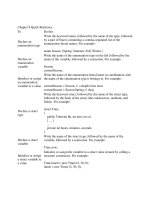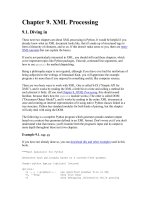Chapter 9 v7 0
Bạn đang xem bản rút gọn của tài liệu. Xem và tải ngay bản đầy đủ của tài liệu tại đây (1.58 MB, 78 trang )
©1996-2016, J.F Kurose and K.W. Ross
Computer Networks
Lectured by:
Nguyen Le Duy Lai
()
Computer
Networking: A Top
Down Approach
7th Edition, Global Edition
Jim Kurose, Keith Ross
Pearson
April 2016
Multimedia Networking
9-1
©1996-2016, J.F Kurose and K.W. Ross
Chapter 9
Multimedia
Networking
Computer
Networking: A Top
Down Approach
7th Edition, Global Edition
Jim Kurose, Keith Ross
Pearson
April 2016
Multimedia Networking 9-2
©1996-2016, J.F Kurose and K.W. Ross
Multimedia networking: outline
9.1 multimedia networking applications
9.2 streaming stored video
9.3 voice-over-IP
9.4 protocols for real-time conversational
applications
9.5 network support for multimedia
Multimedia Networking9-3
§ analog audio signal
sampled at constant rate
• telephone: 8,000
samples/sec
• CD music: 44,100
samples/sec
Đ each sample quantized, i.e.,
rounded
ã e.g., 28=256 possible
quantized values
ã each quantized value
represented by bits,
e.g., 8 bits for 256
values
quantization
error
audio signal amplitude
©1996-2016, J.F Kurose and K.W. Ross
Multimedia: audio
quantized
value of
analog value
analog
signal
time
sampling rate
(N sample/sec)
Multimedia Networking9-4
Multimedia: audio
example rates
§ CD: 1.411 Mbps
§ MP3: 96, 128, 160 kbps
Đ Internet telephony: 5.3 kbps
and up
quantization
error
audio signal amplitude
â1996-2016, J.F Kurose and K.W. Ross
§ example: 8,000 samples/sec,
256 quantized values: 64,000
bps
§ receiver converts bits back to
analog signal:
• some quality reduction
quantized
value of
analog value
analog
signal
time
sampling rate
(N sample/sec)
Multimedia Networking9-5
©1996-2016, J.F Kurose and K.W. Ross
Multimedia: video
§ video: sequence of images
displayed at constant rate
ã e.g., 24 images/sec
Đ digital image: array of pixels
ã each pixel represented
by bits
Đ coding: use redundancy
within and between images
to decrease # bits used to
encode image
• spatial (within image)
• temporal (from one
image to next)
spatial coding example: instead
of sending N values of same
color (all purple), send only two
values: color value (purple) and
number of repeated values (N)
……………………...…
……………………...…
frame i
temporal coding example:
instead of sending
complete frame at i+1,
send only differences from
frame i
frame i+1
Multimedia Networking9-6
©1996-2016, J.F Kurose and K.W. Ross
Multimedia: video
§ CBR: (constant bit rate):
video encoding rate fixed
§ VBR: (variable bit rate):
video encoding rate changes
as amount of spatial,
temporal coding changes
Đ examples:
ã MPEG 1 (CD-ROM) 1.5
Mbps
• MPEG2 (DVD) 3-6 Mbps
• MPEG4 (often used in
Internet, < 1 Mbps)
spatial coding example: instead
of sending N values of same
color (all purple), send only two
values: color value (purple) and
number of repeated values (N)
……………………...…
……………………...…
frame i
temporal coding example:
instead of sending
complete frame at i+1,
send only differences from
frame i
frame i+1
Multimedia Networking9-7
Multimedia networking: 3 application types
Đ streaming, stored audio, video
â1996-2016, J.F Kurose and K.W. Ross
• streaming: can begin playout before downloading entire
file
• stored (at server): can transmit faster than audio/video
will be rendered (implies storing/buffering at client)
ã e.g., YouTube, Netflix, Hulu
Đ conversational voice/video over IP
• interactive nature of human-to-human conversation
limits delay tolerance
• e.g., Skype
Đ streaming live audio, video
ã e.g., live sporting event (futbol)
Multimedia Networking9-8
©1996-2016, J.F Kurose and K.W. Ross
Multimedia networking: outline
9.1 multimedia networking applications
9.2 streaming stored video
9.3 voice-over-IP
9.4 protocols for real-time conversational
applications
9.5 network support for multimedia
Multimedia Networking9-9
©1996-2016, J.F Kurose and K.W. Ross
Cumulative data
Streaming stored video:
1. video
recorded
(e.g., 30
frames/sec)
2. video
sent
network delay
(fixed in this
example)
3. video received,
played out at client
(30 frames/sec) time
streaming: at this time, client
playing out early part of video,
while server still sending later
part of video
Multimedia Networking 9-10
©1996-2016, J.F Kurose and K.W. Ross
Streaming stored video: challenges
§ continuous playout constraint: once client playout
begins, playback must match original timing
• … but network delays are variable (jitter), so
will need client-side buffer to match playout
requirements
Đ other challenges:
ã client interactivity: pause, fast-forward, rewind,
jump through video
• video packets may be lost, retransmitted
Multimedia Networking 9-11
©1996-2016, J.F Kurose and K.W. Ross
constant bit
rate video
transmission
client video
reception
variable
network
delay
constant bit
rate video
playout at client
buffered
video
Cumulative data
Streaming stored video: revisited
time
client playout
delay
§ client-side buffering and playout delay: compensate
for network-added delay, delay jitter
Multimedia Networking 9-12
Client-side buffering, playout
buffer fill level,
Q(t)
playout rate,
e.g., CBR r
variable fill
rate, x(t)
©1996-2016, J.F Kurose and K.W. Ross
video server
client application
buffer, size B
client
Multimedia Networking 9-13
Client-side buffering, playout
buffer fill level,
Q(t)
playout rate,
e.g., CBR r
variable fill
rate, x(t)
©1996-2016, J.F Kurose and K.W. Ross
video server
client application
buffer, size B
client
1. Initial fill of buffer until playout begins at tp
2. playout begins at tp,
3. buffer fill level varies over time as fill rate x(t) varies
and playout rate r is constant
Multimedia Networking 9-14
Client-side buffering, playout
buffer fill level,
Q(t)
playout rate,
e.g., CBR r
variable fill
rate, x(t)
©1996-2016, J.F Kurose and K.W. Ross
video server
client application
buffer, size B
playout buffering: average fill rate (x), playout rate (r):
§ x < r: buffer eventually empties (causing freezing of video
playout until buffer again fills)
§ x > r: buffer will not empty, provided initial playout delay is
large enough to absorb variability in x(t)
• initial playout delay tradeoff: buffer starvation less likely
with larger delay, but larger delay until user begins
watching
Multimedia Networking 9-15
©1996-2016, J.F Kurose and K.W. Ross
Streaming multimedia: UDP
§ server sends at rate appropriate for client
• often: send rate = encoding rate = constant
rate
ã transmission rate can be oblivious to
congestion levels
Đ short playout delay (2-5 seconds) to remove
network jitter
§ error recovery: application-level, time permitting
§ RTP [RFC 2326]: multimedia payload types
§ UDP may not go through firewalls
Multimedia Networking 9-16
Streaming multimedia: HTTP
§ multimedia file retrieved via HTTP GET
§ send at maximum possible rate under TCP
variable
rate, x(t)
©1996-2016, J.F Kurose and K.W. Ross
video
file
TCP send
buffer
server
TCP receive
buffer
application
playout buffer
client
§ fill rate fluctuates due to TCP congestion control,
retransmissions (in-order delivery)
§ larger playout delay: smooth TCP delivery rate
§ HTTP/TCP passes more easily through firewalls
Multimedia Networking 9-17
©1996-2016, J.F Kurose and K.W. Ross
Multimedia networking: outline
9.1 multimedia networking applications
9.2 streaming stored video
9.3 voice-over-IP
9.4 protocols for real-time conversational
applications
9.5 network support for multimedia
Multimedia Networking9-18
Voice-over-IP (VoIP)
Đ VoIP end-end-delay requirement: needed to maintain
conversational aspect
â1996-2016, J.F Kurose and K.W. Ross
•
•
•
•
higher delays noticeable, impair interactivity
< 150 msec: good
> 400 msec bad
includes application-level (packetization, playout),
network delays
§ session initialization: how does callee advertise IP
address, port number, encoding algorithms?
§ value-added services: call forwarding, screening,
recording
§ emergency services: 911
Multimedia Networking 9-19
VoIP characteristics
Đ speakers audio: alternating talk spurts, silent
periods.
ã 64 kbps during talk spurt
ã pkts generated only during talk spurts
â1996-2016, J.F Kurose and K.W. Ross
• 20 msec chunks at 8 Kbytes/sec: 160 bytes of data
§ application-layer header added to each chunk
§ chunk+header encapsulated into UDP or TCP
segment
§ application sends segment into socket every 20
msec during talkspurt
Multimedia Networking 9-20
VoIP: packet loss, delay
§ network loss: IP datagram lost due to network
congestion (router buffer overflow)
§ delay loss: IP datagram arrives too late for playout
at receiver
â1996-2016, J.F Kurose and K.W. Ross
ã delays: processing, queueing in network; end-system
(sender, receiver) delays
• typical maximum tolerable delay: 400 ms
§ loss tolerance: depending on voice encoding, loss
concealment, packet loss rates between 1% and
10% can be tolerated
Multimedia Networking 9-21
©1996-2016, J.F Kurose and K.W. Ross
constant bit
rate
transmission
variable
network
delay
(jitter)
client
reception
constant bit
rate playout
at client
buffered
data
Cumulative data
Delay jitter
time
client playout
delay
§ end-to-end delays of two consecutive packets:
difference can be more or less than 20 msec
(transmission time difference)
Multimedia Networking 9-22
©1996-2016, J.F Kurose and K.W. Ross
VoIP: fixed playout delay
§ receiver attempts to playout each chunk exactly q
msecs after chunk was generated.
• chunk has time stamp t: play out chunk at t+q
• chunk arrives after t+q: data arrives too late
for playout: data lost
Đ tradeoff in choosing q:
ã large q: less packet loss
• small q: better interactive experience
Multimedia Networking 9-23
VoIP: fixed playout delay
§
§
§
§
sender generates packets every 20 msec during talk spurt.
first packet received at time r
first playout schedule: begins at p
second playout schedule: begins at p’
©1996-2016, J.F Kurose and K.W. Ross
packets
loss
packets
generated
packets
received
playout schedule
p' - r
playout schedule
p-r
time
r
p
p'
Multimedia Networking 9-24
Adaptive playout delay (1)
â1996-2016, J.F Kurose and K.W. Ross
Đ goal: low playout delay, low late loss rate
§ approach: adaptive playout delay adjustment:
• estimate network delay, adjust playout delay at
beginning of each talk spurt
• silent periods compressed and elongated
• chunks still played out every 20 msec during talk spurt
§ adaptively estimate packet delay: (EWMA exponentially weighted moving average, recall TCP RTT
estimate):
di = (1-a)di-1 + a (ri – ti)
delay estimate
after ith packet
small constant,
e.g. 0.1
time received - time sent
(timestamp)
measured delay of ith packet
Multimedia Networking 9-25









